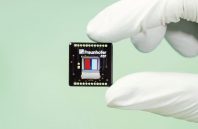Scientists at the Fraunhofer Institute for Organic Electronics, Electron Beam and Plasma Technology FEP have developed a miniaturized phosphorescence sensor that combines marker and sensor on a small chip surface about the size of a thumbnail. OLED control and the sensor front-end are integrated into a silicon chip. The chemical marker is excited by modulated blue OLED light. The phosphorescent response of the marker is then detected directly inside the sensor chip. The marker determines the substance to be measured.
The current sensor for exciting the oxygen-sensitive marker emits blue light in an area of approximately 4.7 by 2.2 mm. The decay time of the light emitted by the marker after excitation is a parameter of the oxygen concentration in the environment. The significantly lower phosphorescence signal is recorded via integrated silicon photodiodes, amplified locally in the chip and subsequently evaluated in relation to the excitation signal with regard to the phase shift. In the future, the researchers plan to reduce the size of the chip significantly, ultimately achieving a total chip size of less than 2 by 2 mm.

 (585) 768-2513
(585) 768-2513

